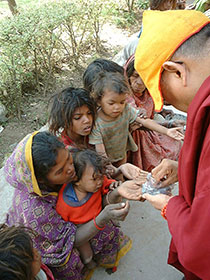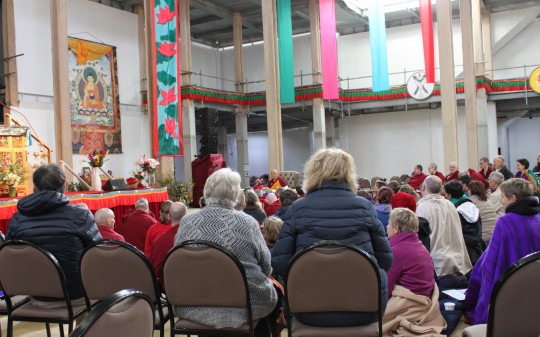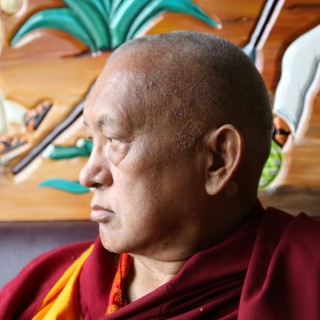- Home
- FPMT Homepage
Foundation for the Preservation of the Mahayana Tradition
The FPMT is an organization devoted to preserving and spreading Mahayana Buddhism worldwide by creating opportunities to listen, reflect, meditate, practice and actualize the unmistaken teachings of the Buddha and based on that experience spreading the Dharma to sentient beings. We provide integrated education through which people’s minds and hearts can be transformed into their highest potential for the benefit of others, inspired by an attitude of universal responsibility and service. We are committed to creating harmonious environments and helping all beings develop their full potential of infinite wisdom and compassion. Our organization is based on the Buddhist tradition of Lama Tsongkhapa of Tibet as taught to us by our founders Lama Thubten Yeshe and Lama Thubten Zopa Rinpoche.
- Willkommen
Die Stiftung zur Erhaltung der Mahayana Tradition (FPMT) ist eine Organisation, die sich weltweit für die Erhaltung und Verbreitung des Mahayana-Buddhismus einsetzt, indem sie Möglichkeiten schafft, den makellosen Lehren des Buddha zuzuhören, über sie zur reflektieren und zu meditieren und auf der Grundlage dieser Erfahrung das Dharma unter den Lebewesen zu verbreiten.
Wir bieten integrierte Schulungswege an, durch denen der Geist und das Herz der Menschen in ihr höchstes Potential verwandelt werden zum Wohl der anderen – inspiriert durch eine Haltung der universellen Verantwortung und dem Wunsch zu dienen. Wir haben uns verpflichtet, harmonische Umgebungen zu schaffen und allen Wesen zu helfen, ihr volles Potenzial unendlicher Weisheit und grenzenlosen Mitgefühls zu verwirklichen.
Unsere Organisation basiert auf der buddhistischen Tradition von Lama Tsongkhapa von Tibet, so wie sie uns von unseren Gründern Lama Thubten Yeshe und Lama Thubten Zopa Rinpoche gelehrt wird.
- Bienvenidos
La Fundación para la preservación de la tradición Mahayana (FPMT) es una organización que se dedica a preservar y difundir el budismo Mahayana en todo el mundo, creando oportunidades para escuchar, reflexionar, meditar, practicar y actualizar las enseñanzas inconfundibles de Buda y en base a esa experiencia difundir el Dharma a los seres.
Proporcionamos una educación integrada a través de la cual las mentes y los corazones de las personas se pueden transformar en su mayor potencial para el beneficio de los demás, inspirados por una actitud de responsabilidad y servicio universales. Estamos comprometidos a crear ambientes armoniosos y ayudar a todos los seres a desarrollar todo su potencial de infinita sabiduría y compasión.
Nuestra organización se basa en la tradición budista de Lama Tsongkhapa del Tíbet como nos lo enseñaron nuestros fundadores Lama Thubten Yeshe y Lama Zopa Rinpoche.
A continuación puede ver una lista de los centros y sus páginas web en su lengua preferida.
- Bienvenue
L’organisation de la FPMT a pour vocation la préservation et la diffusion du bouddhisme du mahayana dans le monde entier. Elle offre l’opportunité d’écouter, de réfléchir, de méditer, de pratiquer et de réaliser les enseignements excellents du Bouddha, pour ensuite transmettre le Dharma à tous les êtres. Nous proposons une formation intégrée grâce à laquelle le cœur et l’esprit de chacun peuvent accomplir leur potentiel le plus élevé pour le bien d’autrui, inspirés par le sens du service et une responsabilité universelle. Nous nous engageons à créer un environnement harmonieux et à aider tous les êtres à épanouir leur potentiel illimité de compassion et de sagesse. Notre organisation s’appuie sur la tradition guéloukpa de Lama Tsongkhapa du Tibet, telle qu’elle a été enseignée par nos fondateurs Lama Thoubtèn Yéshé et Lama Zopa Rinpoché.
Visitez le site de notre Editions Mahayana pour les traductions, conseils et nouvelles du Bureau international en français.
Voici une liste de centres et de leurs sites dans votre langue préférée
- Benvenuto
L’FPMT è un organizzazione il cui scopo è preservare e diffondere il Buddhismo Mahayana nel mondo, creando occasioni di ascolto, riflessione, meditazione e pratica dei perfetti insegnamenti del Buddha, al fine di attualizzare e diffondere il Dharma fra tutti gli esseri senzienti.
Offriamo un’educazione integrata, che può trasformare la mente e i cuori delle persone nel loro massimo potenziale, per il beneficio di tutti gli esseri, ispirati da un’attitudine di responsabilità universale e di servizio.
Il nostro obiettivo è quello di creare contesti armoniosi e aiutare tutti gli esseri a sviluppare in modo completo le proprie potenzialità di infinita saggezza e compassione.
La nostra organizzazione si basa sulla tradizione buddhista di Lama Tsongkhapa del Tibet, così come ci è stata insegnata dai nostri fondatori Lama Thubten Yeshe e Lama Zopa Rinpoche.
Di seguito potete trovare un elenco dei centri e dei loro siti nella lingua da voi prescelta.
- 欢迎 / 歡迎
简体中文
“护持大乘法脉基金会”( 英文简称:FPMT。全名:Foundation for the Preservation of the Mahayana Tradition) 是一个致力于护持和弘扬大乘佛法的国际佛教组织。我们提供听闻,思维,禅修,修行和实证佛陀无误教法的机会,以便让一切众生都能够享受佛法的指引和滋润。
我们全力创造和谐融洽的环境, 为人们提供解行并重的完整佛法教育,以便启发内在的环宇悲心及责任心,并开发内心所蕴藏的巨大潜能 — 无限的智慧与悲心 — 以便利益和服务一切有情。
FPMT的创办人是图腾耶喜喇嘛和喇嘛梭巴仁波切。我们所修习的是由两位上师所教导的,西藏喀巴大师的佛法传承。
繁體中文
護持大乘法脈基金會”( 英文簡稱:FPMT。全名:Found
ation for the Preservation of the Mahayana Tradition ) 是一個致力於護持和弘揚大乘佛法的國際佛教組織。我們提供聽聞, 思維,禪修,修行和實證佛陀無誤教法的機會,以便讓一切眾生都能 夠享受佛法的指引和滋潤。 我們全力創造和諧融洽的環境,
為人們提供解行並重的完整佛法教育,以便啟發內在的環宇悲心及責 任心,並開發內心所蘊藏的巨大潛能 — 無限的智慧與悲心 – – 以便利益和服務一切有情。 FPMT的創辦人是圖騰耶喜喇嘛和喇嘛梭巴仁波切。
我們所修習的是由兩位上師所教導的,西藏喀巴大師的佛法傳承。 察看道场信息:
- FPMT Homepage
- News/Media
-
- Study & Practice
-
-
- About FPMT Education Services
- Latest News
- Programs
- New to Buddhism?
- Buddhist Mind Science: Activating Your Potential
- Heart Advice for Death and Dying
- Discovering Buddhism
- Living in the Path
- Exploring Buddhism
- FPMT Basic Program
- FPMT Masters Program
- FPMT In-Depth Meditation Training
- Maitripa College
- Lotsawa Rinchen Zangpo Translator Program
- Universal Education for Compassion & Wisdom
- Online Learning Center
-
- Prayers & Practice Materials
- Overview of Prayers & Practices
- Full Catalogue of Prayers & Practice Materials
- Explore Popular Topics
- Benefiting Animals
- Chenrezig Resources
- Death & Dying Resources
- Lama Chopa (Guru Puja)
- Lama Zopa Rinpoche: Compendium of Precious Instructions
- Lama Zopa Rinpoche: Life Practice Advice
- Lama Zopa Rinpoche Practice Series
- Lamrim Resources
- Mantras
- Prayer Book Updates
- Purification Practices
- Sutras
- Thought Transformation (Lojong)
- Audio Materials
- Dharma Dates - Tibetan Calendar
- Translation Services
- Publishing Services
- Ways to Offer Support
- Prayers & Practice Materials
-
- Teachings and Advice
- Find Teachings and Advice
- Lama Zopa Rinpoche Advice Page
- Lama Zopa Rinpoche: Compendium of Precious Instructions
- Lama Zopa Rinpoche Video Teachings
- ༧སྐྱབས་རྗེ་བཟོད་པ་རིན་པོ་ཆེ་མཆོག་ནས་སྩལ་བའི་བཀའ་སློབ་བརྙན་འཕྲིན།
- Podcasts
- Lama Yeshe Wisdom Archive
- Buddhism FAQ
- Dharma for Young People
- Resources on Holy Objects
- Teachings and Advice
-
-
*If a menu item has a submenu clicking once will expand the menu clicking twice will open the page.
-
-
- Centers
-
- Teachers
-
- Projects
-
-
-
-
*If a menu item has a submenu clicking once will expand the menu clicking twice will open the page.
-
-
- FPMT
-
-
-
-
-
Whether one believes in a religion or not, and whether one believes in rebirth or not, there isn’t anyone who doesn’t appreciate kindness and compassion.
His Holiness the Dalai Lama
-
-
-
- Shop
-
-
-
The Foundation Store is FPMT’s online shop and features a vast selection of Buddhist study and practice materials written or recommended by our lineage gurus. These items include homestudy programs, prayers and practices in PDF or eBook format, materials for children, and other resources to support practitioners.
Items displayed in the shop are made available for Dharma practice and educational purposes, and never for the purpose of profiting from their sale. Please read FPMT Foundation Store Policy Regarding Dharma Items for more information.
-
-
Lama Zopa Rinpoche News and Advice
30
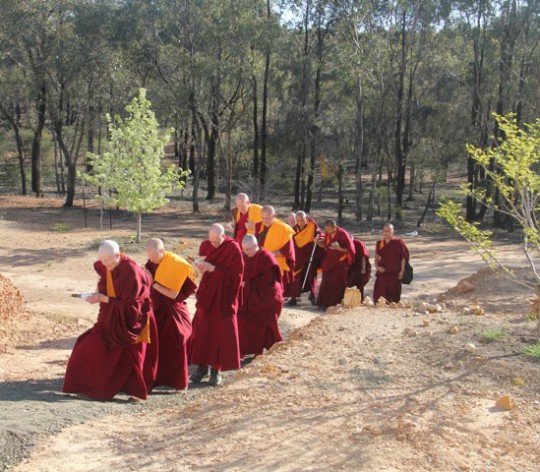
Sangha in procession leading Lama Zopa Rinpoche to the Great Stupa of Universal Compassion, September 2014. Photo by Drolkar McCallum.
Lama Zopa Rinpoche continues to give the extremely rare lung (oral transmission) of the 21 chapter version of the Golden Light Sutra at the Great Stupa of Universal Compassion in Australia. As part of the month-long Bodhicaryavatara and Rinjung Gyatsa retreat, Rinpoche is offering the lung.
Rinpoche explained that even people listening to the video streaming of the lung can take it as an oral transmission. By having received an oral transmission of the sutra, it becomes 100 times more powerful when you recite it. (You can find the Golden Light Sutra in 14 different languages here.)
You can watch the video recordings of the oral transmission of the Golden Light Sutra on FPMT’s Livestream page. (Click to watch Part 1 of the transmission, Part 2, Part 3, and Part 4.)
https://new.livestream.com/accounts/2729219/events/3329712/videos/63498210/player?width=560&height=315&autoPlay=false&mute=false
On Monday, September 29, Rinpoche was led to the Great Stupa in a procession of six Sangha members as a way of creating merit to be able to receive this incredible oral transmission. One nun walked around the gompa making billowing incense offerings throughout the transmission. There are 57 Sangha members in attendance at the retreat.
Live webcasts and recording of all the daily sessions with Lama Zopa Rinpoche at the retreat in Australia can be watched on the FPMT Livestream page. Audio MP3 recordings of the retreat sessions with Rinpoche are available for download with translation into French, Italian and Spanish.
Lama Zopa Rinpoche is the spiritual director of the Foundation for the Preservation of Mahayana Tradition (FPMT), a Tibetan Buddhist organization dedicated to the transmission of the Mahayana Buddhist tradition and values worldwide through teaching, meditation and community service.
26
Retreat with Lama Zopa Rinpoche Begins in Australia [Video]
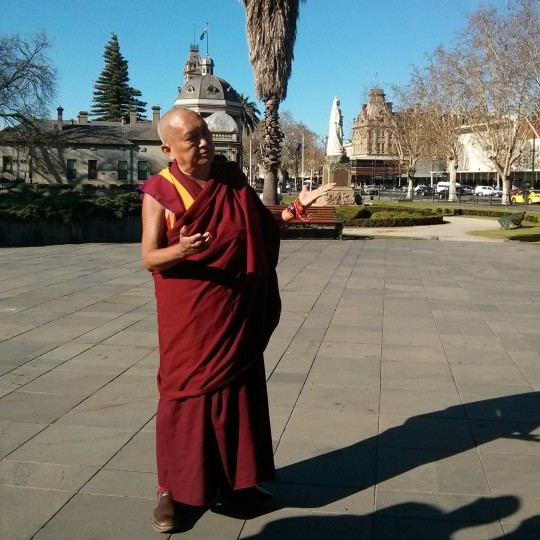
Lama Zopa Rinpoche giving spontaneous teaching on making offerings in Bendigo, Victoria, Australia, September 21, 2014. Photo by Laura Miller.
FPMT spiritual director Lama Zopa Rinpoche gave his first teaching for the month-long Bodhicaryavatara and Rinjung Gyatsa retreat on Friday, September 26, at the Great Stupa of Universal Compassion near Bendigo, Australia. About 250 people are attending the beginning of the retreat, including many long-time students and Sangha as well as FPMT center directors.
Rinpoche began the afternoon session on Friday doing gegtor, a short puja to dispel interferences, for the retreat and also for any sentient being who needed it. Then Rinpoche said the elaborate Golden Light Sutra needed to be recited and decided to do it in the gompa (in the Great Stupa) so all present would receive the oral transmission of it.
Before giving the transmission, Rinpoche thanked FPMT International Office and especially Merry Colony, former director of FPMT Education Services, for arranging all the various translations of the sutra. (You can find the Golden Light Sutra in 14 different languages here.) Rinpoche said that creating these translations and making them available was an incredible service to the world. Rinpoche next gave a moving motivation on bodhichitta and then began the oral transmission of the elaborate Golden Light Sutra as far as the first chapter.
A video recording of the afternoon teaching as well as live webcasts and recording of all the daily sessions with Rinpoche can be watched on the Lama Zopa Rinpoche in Australia Livestream page.
https://new.livestream.com/accounts/2729219/events/3329712/videos/63160907/player?width=560&height=315&autoPlay=false&mute=false
Rinpoche also came to the evening session on Friday, leading retreatants in the protector prayers. Rinpoche explained the way to motivate before every prayer, led a cymbal offering and made strong dedications, illustrating the essence of how to think before and after every practice.
Lama Zopa Rinpoche is the spiritual director of the Foundation for the Preservation of Mahayana Tradition (FPMT), a Tibetan Buddhist organization dedicated to the transmission of the Mahayana Buddhist tradition and values worldwide through teaching, meditation and community service.
- Tagged: australia retreat 2014, lama zopa rinpoche, video, webcast
- 0
21
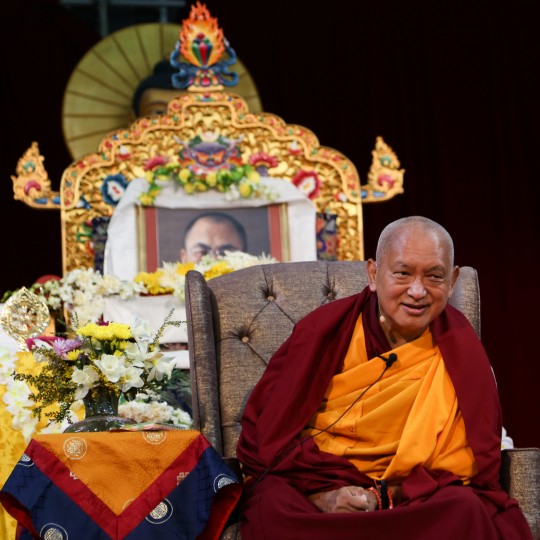
Lama Zopa Rinpoche during public talk at Great Stupa of Universal Compassion, Australia, September 20, 2014. Photo by Ven. Thubten Kunsang.
More than 600 people came to the Great Stupa of Universal Compassion on Saturday, September 20, to attend Lama Zopa Rinpoche’s public teaching. In additional to attendees of the CPMT 2014 meeting, many people traveled from Melbourne and other parts of Australia to see Rinpoche at the Great Stupa, which is near Bendigo, Victoria.
Videos of the talk are available for streaming. Rinpoche taught in two sessions on the “Bodhisattva Attitude.”
https://new.livestream.com/accounts/2729219/events/3332581/videos/62561679/player?width=560&height=315&autoPlay=false&mute=false
Rinpoche took audience questions at the beginning of the second section. One question was: “What is the relationship between study and practice? Can the two occur simultaneously?”
Rinpoche replied, “When you are receiving teachings on Buddhist philosophy, such as studying the Basic Program or Masters Program, the programs that the FPMT centers have, the extensive subjects, Buddha’s teachings and the extensive commentaries by Indian pandits, Nagarjuna, Chandrakirti, Asanga, and so forth, and the enlightened beings of Tibet such as Lama Tsongkhapa and so forth, what they taught and what they experienced, even you are studying a very big subject, but you integrate it into lam-rim. When you are practicing lam-rim — correctly devoting to the virtuous friend, renunciation, bodhichitta, right view — when you practice those, the essence of those great philosophy teachings is practiced. If you don’t practice lam-rim, then your life is like [an empty] supermarket — building is there, but there is no food at all there to sell, no fruits, no vegetables, no cheese, no meat. Everything is empty; there is nothing to buy. It is like that, like an empty can or an empty purse — no money in the purse — or an empty stomach. …
“So therefore I think study lam-rim, essence of Dharma, first. Then either with that or after that, study philosophy. Then you know how to listen to teachings and make them effective for your mind. Otherwise if you don’t understand lam-rim, it doesn’t become that. The teachings that you listen to you don’t know how to make useful for your mind. Even reading Dharma texts becomes difficult to make useful for your mind without knowing lam-rim.”
Copies of Rinpoche’s book Bodhisattva Attitude: How to Dedicate Your Life to Others were offered to all in attendance by the Lama Yeshe Wisdom Archive.
After a brief interlude, Lama Zopa Rinpoche will be leading the month-long Bodhicaryavatara and Rinjung Gyatsa retreat, September 25-October 23, at the Great Stupa. Rinpoche’s teachings will be webcast live on the retreat Livestream page.
Lama Zopa Rinpoche is the spiritual director of the Foundation for the Preservation of Mahayana Tradition(FPMT), a Tibetan Buddhist organization dedicated to the transmission of the Mahayana Buddhist tradition and values worldwide through teaching, meditation and community service.
19
Long Life Puja for Lama Zopa Rinpoche
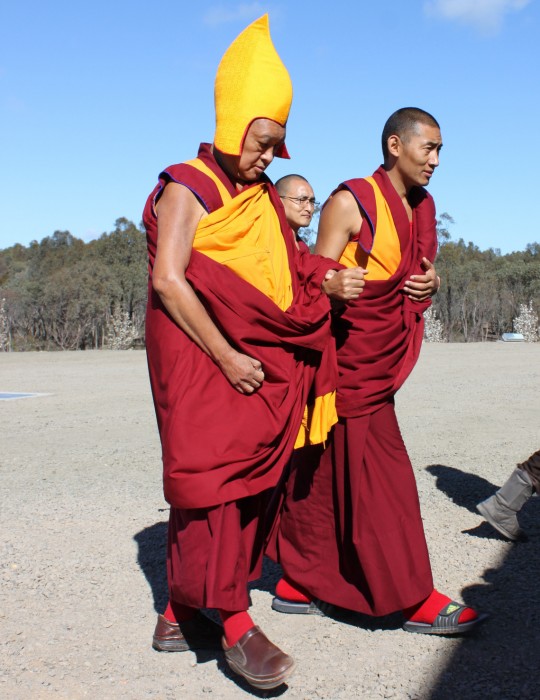
Lama Zopa Rinpoche arriving at the long life puja at Great Stupa of Universal Compassion, Australia, September 19, 2014. Photo by Laura Miller.
To close the CPMT 2014 meeting, a long life puja with the five dakinis was offered to FPMT spiritual director Lama Zopa Rinpoche on Friday, September 19, in the Great Stupa of Universal Compassion. A video recording of the puja is available on the CPMT livestream page.
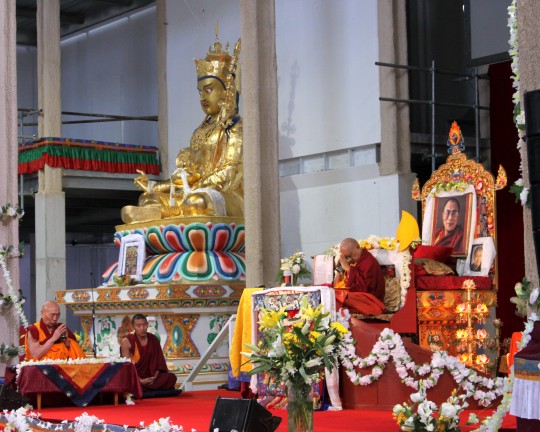
Lama Zopa Rinpoche during long life puja with Geshe Doga, Great Stupa of Universal Compassion, Australia, September 19, 2014. Photo by Laura Miller.
Four FPMT resident geshes were present for the puja: Khen Rinpoche Geshe Chonyi, abbot of Kopan Monastery and resident geshe at Amitabha Buddhist Centre; Geshe Lobsang Doga, Tara Institute; Geshe Ngawang Samten, Vajrayana Institute; and Geshe Phuntsok Tsultrem, Chenrezig Institute. In addition, more than 40 Sangha members and 130 lay students attended.
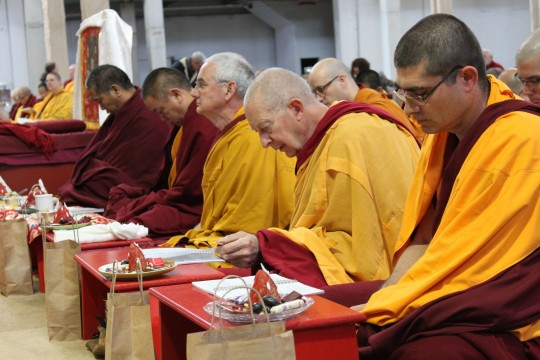
Geshe Ngawang Samten, Geshe Phuntsok Tsultrem, Vens. Roger Kunsang, Gyatso and Michael Yeshe during long life puja, Great Stupa of Universal Compassion, Australia, September 2014. Photo by Laura Miller.
Ven. Tenzin Tsapel, resident teacher of the Golden Light Sutra Center in Mongolia, beautifully led the chanting in her role as umze. The five dakinis made a dramatic entrance into the gompa, performing the traditional dance. Praises to Lama Zopa Rinpoche from FPMT centers around the world were read by Helen Patrin, coordinator of FPMT Australia; Drolkar McCallum, FPMT North America regional coordinator; and Tara Melwani, FPMT South East Asia regional coordinator.
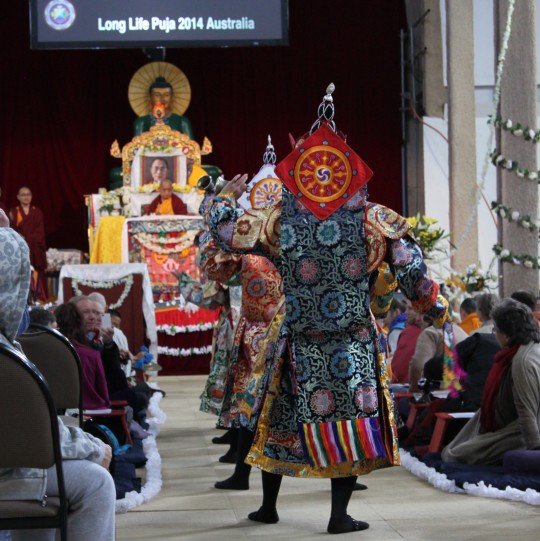
Five dakini dancers entering the gompa, Great Stupa of Universal Compassion, Australia, September 19, 2014. Photo by Laura Miller.
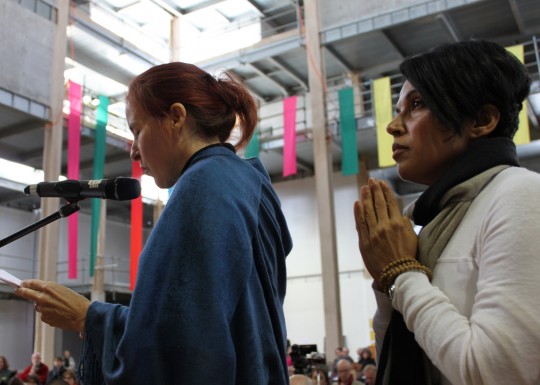
Drolkar McCallum reading the praises for Lama Zopa Rinpoche with Tara Melwani and Helen Patrin (not pictured), Great Stupa of Universal Compassion, Australia, September 19, 2014. Photo by Laura Miller.
Lama Zopa Rinpoche did an extensive dedication at the end of the puja, including all the people working within the FPMT mandala and all FPMT centers, projects and services. After the puja, a lunch was served for all present.
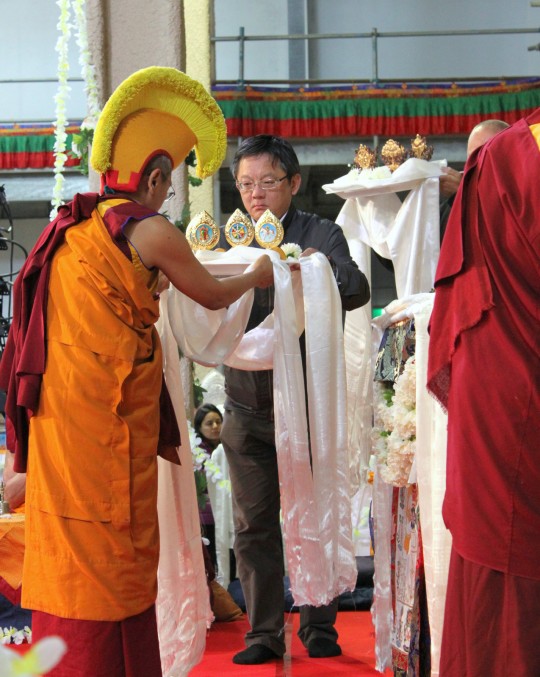
Steve Lin from FPMT Taiwan offering the eight royal emblems during long life puja, Great Stupa of Universal Compassion, Australia, September 19, 2014. Photo by Laura Miller.
For more on the CPMT 2014 meeting, including photos and daily summaries, visit Mandala‘s blog.
More information, photos and updates about FPMT spiritual director Lama Zopa Rinpoche can be found on Rinpoche’s webpage. If you’d like to receive news of Lama Zopa Rinpoche via email, sign up to Lama Zopa Rinpoche News.
- Tagged: cpmt, cpmt 2014, lama zopa rinpoche, long life puja
- 1
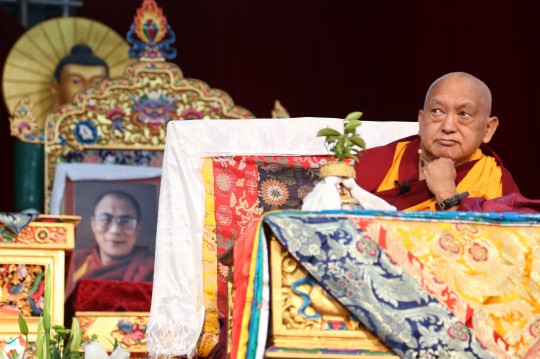
Lama Zopa Rinpoche giving the preliminary teaching before the long life initiation during the CPMT 2014 meeting, Great Stupa of Universal Compassion, Australia, September 17, 2014. Photo by Ven. Thubten Kunsang.
Lama Zopa Rinpoche gave an exhilarating teaching on the merely labeled ‘I’ and emptiness during the preliminary teachings for the Amitayus long life initiation given during the CPMT 2014 meeting in Australia. A recording of the teaching is now available on the CPMT livestream page.
Rinpoche will be webcast live giving the concluding talk and dedication of the CPMT 2014 meeting on Thursday, September 18, at 4 p.m. AEST (UTC+10).
Here’s an excerpt from a long letter Rinpoche dictated to Ven. Holly Ansett in 2008, published on the Lama Yeshe Wisdom Archive, with extensive advice on emptiness and the merely imputed ‘I’. Rinpoche advised:
“… The I, or the self, action and object are dependent arisings. The I exists being imputed in dependence upon its base, the aggregates. Here aggregates refers to form, feeling, recognition, compounded aggregates and consciousness. The I exists in dependence upon the aggregates; the I is merely imputed to the base, the aggregates, which exist in mere name. So, the I is empty of existing from its own side, empty of existing by its nature; it does not exist inherently.
“It is the same with any action. How an action actually exists is as a dependent arising. It is not independent, but a dependent arising. ‘Action’ is labeled on what the body, speech or mind does. It exists, but dependently. Any action, no matter what name it is given, is merely imputed by the mind. It is not independent, but a dependent arising. Action does not exist from its own side; it does not exist by its nature; it does not exist inherently, or truly.
“It is the same with any object. In dependence upon the base and the thought, something is labeled ‘object.’ The object came from the mind, not from the base. You could say that it exists from the side of the mind, or in dependence upon the mind, which imputes, or designates, it. But it also exists in relation to its base. So, it is the same with an object: it does not exist from its own side.
“Therefore, I, action and object are all totally empty. They are not nonexistent, which is nihilism, but they do not exist from their own side. They do exist from the side of the mind in relation to the base, but they do not exist from their own side. Therefore, they are totally empty from their own side. This is the same with all the rest of phenomena. Nothing exists from its own side. While they exist, all phenomena are totally empty of existing from their own side. They exist in mere name and function in mere name, but that doesn’t mean that they are nonexistent.
“This is a very subtle explanation of how the I, action, object and all other phenomena exist. It can be explained in a gross way, but here this is an extremely subtle explanation. Phenomena exist in mere name, being merely imputed by the mind. Here one needs to study and one needs to analyze, which means really check how things exist. …”
The complete advice “The Merely Imputed I” is part of “Lama Zopa Rinpoche’s Online Advice Book” on the website of Lama Yeshe Wisdom Archive.
Mandala will be covering the CPMT meeting with daily updates and new photos.
More information, photos and updates about FPMT spiritual director Lama Zopa Rinpoche can be found on Rinpoche’s webpage. If you’d like to receive news of Lama Zopa Rinpoche via email, sign up to Lama Zopa Rinpoche News.
15
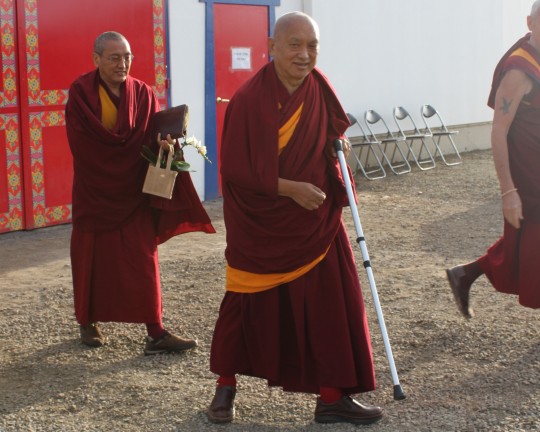
Lama Zopa Rinpoche leaving the Great Stupa of Universal Compassion after the morning motivation, Victoria, Australia, September 16, 2014. Photo by Laura Miller.
The video of Lama Zopa Rinpoche’s morning motivation for Day 4 of CPMT 2014 meeting, September 16, is now available to watch online. Rinpoche has been attending many of the session of the CPMT 2014 meeting currently taking place at the Great Stupa of Universal Compassion near Bendigo, Australia.
On Day 5, September 17, Rinpoche’s teaching before the long life initiation will be webcast live at 9 a.m. local time (AEST, UTC+10, click here for time zone conversions).
On Day 6, September 18, Rinpoche’s closing remarks for the CPMT 2014 meeting will also be webcast live at 4 p.m. local time (AEST, UTC+10, click here for time zone conversions).
On Day 7, September 19, Rinpoche’s teaching for the long life puja will be webcast live at 9 a.m. local time (AEST, UTC+10, click here for time zone conversions). All these sessions will be made available after the webcast as recorded video at the same link.
Then on September 20, Rinpoche’s public talk at the Great Stupa of Universal Compassion will be webcast live and available afterwards as video for streaming. Following that, the Bodhicaryavatara and Rinjung Gyatsa retreat, September 25-October 23, will also have Rinpoche’s teachings webcast live.
Mandala will be covering the CPMT meeting with daily updates and new photos.
Mandala brings you news of Lama Zopa Rinpoche and of activities, teachings and events from over 160 FPMT centers, projects and services around the globe. If you like what you read on Mandala, consider becoming a Friend of FPMT, which supports our work.
- Tagged: cpmt, cpmt 2014, lama zopa rinpoche
- 0
14

Lama Zopa Rinpoche listening to a question during CPMT 2014, Great Stupa of Universal Compassion, Australia, September 2014. Photo by Laura Miller.
Lama Zopa Rinpoche arrived at the Great Stupa of Universal Compassion during the morning tea break on the second day (September 14) of the CPMT 2014 meeting, currently being held at the Great Stupa of Universal Compassion in Australia. After tea, Rinpoche joined a small group discussion on the proposed idea for an international FPMT Advisory Council. After lunch Rinpoche attended the presentation on FPMT Education Programs and participated in a small group discussion on the topic. Rinpoche then had an open question and answer session with participants.
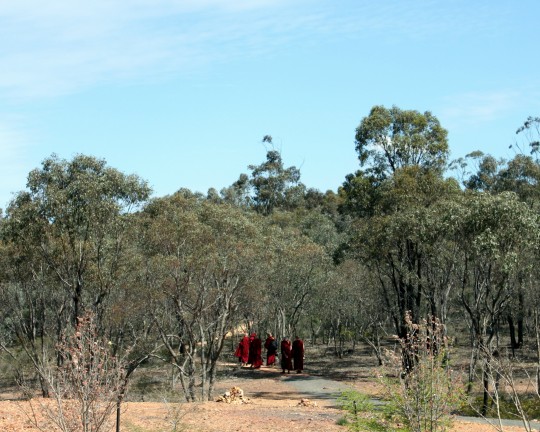
Lama Zopa Rinpoche following the path from the Great Stupa of Universal Compassion to Thubten Shedrup Ling, Victoria, Australia, September 14, 2014. Photo by Laura Miller.
For more on CPMT 2014, visit Mandala’s blog.
Lama Zopa Rinpoche is the spiritual director of the Foundation for the Preservation of Mahayana Tradition (FPMT), a Tibetan Buddhist organization dedicated to the transmission of the Mahayana Buddhist tradition and values worldwide through teaching, meditation and community service.
- Tagged: cpmt, cpmt 2014, lama zopa rinpoche
- 0
12
Lama Zopa Rinpoche at Great Stupa of Universal Compassion, Live Webcast
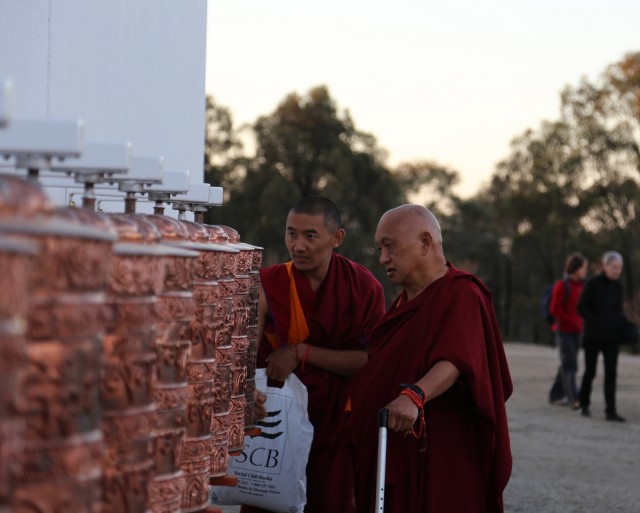
Lama Zopa Rinpoche turning the prayer wheels outside the Great Stupa at dusk, Australia, September 12, 2014. Photo by Ven. Thubten Kunsang.
Lama Zopa Rinpoche arrived at Thubten Shedrup Ling, next to the Great Stupa of Universal Compassion, on Thursday night, September 11. Rinpoche is attending the five-day CPMT meeting and leading the month-long Bodhicaryavatara and Rinjung Gyatsa retreat, September 25-October 23, at the Great Stupa.
Rinpoche’s opening talk at the CPMT meeting on Saturday, September 13, at 10:15 a.m. AEST will be streamed live. (Click here for time zone conversions). For up-to-date information on CPMT webcasts of Rinpoche, visit the CPMT Livestream page.
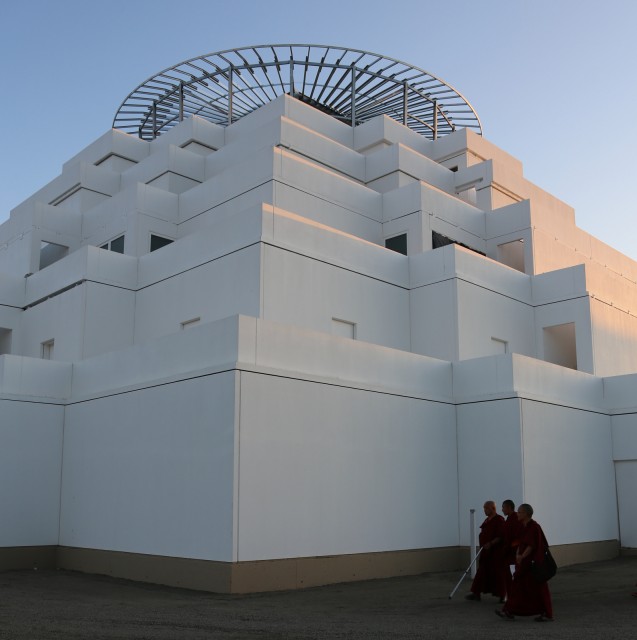
Lama Zopa Rinpoche circumambulating the Great Stupa of Universal Compassion, Australia, September 12, 2014. Photo by Ven. Thubten Kunsang.
On Friday, September 12, Rinpoche circumambulated the Great Stupa and turned the newly installed prayer wheels on the outside of the building. Rinpoche then gave an impromptu teaching on the proper visualization one should do while spinning the wheels.
For more on the CPMT meeting, including updates and photos, visit Mandala‘s blog.
Lama Zopa Rinpoche is the spiritual director of the Foundation for the Preservation of Mahayana Tradition (FPMT), a Tibetan Buddhist organization dedicated to the transmission of the Mahayana Buddhist tradition and values worldwide through teaching, meditation and community service.
“If we generate compassion, we become a friend to everybody and everyone becomes our friend. With this positive attitude, compassion, toward everyone, others also become friendly toward us so we receive no harm from them, only benefit, only help. This way, there’s success in our life. …
“… Each of us here is completely responsible for everybody’s happiness, for every sentient being’s happiness. Not only human beings, not only that, but for all the rest of the sentient beings. Each insect we see on the road, each fly, each bird, each dog, each worm we see on the ground, we are responsible. Each of us here is responsible for the happiness of every single sentient being that we see around us in everyday life, starting from that to all the rest of the sentient beings. So, if we don’t practice compassion, if we only follow the ego, the self-cherishing thought, there is danger to others, starting from the family, starting from the people nearest us to all the rest of the sentient beings. They receive harm from us, directly or indirectly, from life to life.”
Excerpted from Lama Zopa Rinpoche’s teachings at the 24th Kopan lam-rim course in Nepal, 1991. These teachings are included in the ebook Practicing the Unmistaken Path: Lam-rim Teachings from Kopan 1991, due out in November from Lama Yeshe Wisdom Archive.
Learn more about Lama Zopa Rinpoche, spiritual director of the Foundation for the Preservation of Mahayana Tradition (FPMT), and Rinpoche’s vision for a better world. Sign up to receive news and updates.
- Tagged: lama zopa rinpoche, universal responsibility
- 0
10
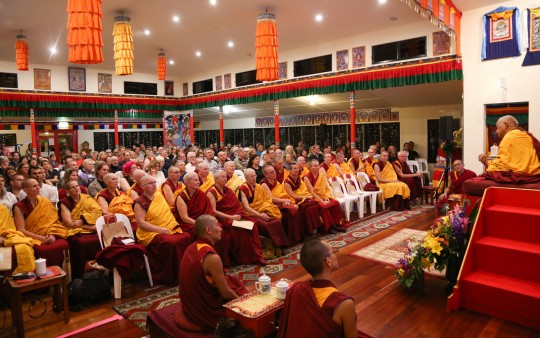
Lama Zopa Rinpoche giving teachings to Sangha and lay students at Chenrezig Institute, Eudlo, Australia, September 2014. Photo by Ven. Roger Kunsang.
Lama Zopa Rinpoche has given much advice to Sangha, which you can find in Lama Zopa Rinpoche’s Online Advice Book. Here’s an excerpt of Rinpoche’s advice on living as a monk, given several years ago in Bodhgaya:
“Morality is the road to liberation from samsara. With morality, it’s easy. Without morality, life creates obstacles for realizations, and then it creates sufferings. It destroys realizations and causes rebirths in lower realms.
“People are looking for happiness, but the method is important. Hunting and killing animals is creating suffering. Other people commit suicide; they kill themselves while they are looking for happiness. The aim for everyone is reaching happiness.
“Maybe it’s not possible to do it every day, but at least once a week or every two or four days we should go over the sutra looking at the benefits of the vows. This is fuel and gives us energy. It is very important. It makes the mind strong, directs the mind to be strong, and strengthens the mind of renunciation. …”
Learn more about Lama Zopa Rinpoche, spiritual director of the Foundation for the Preservation of Mahayana Tradition (FPMT), and Rinpoche’s vision for a better world. Sign up to receive news and updates.
9
Lama Zopa Rinpoche at Chenrezig Institute for 40th Anniversary

Lama Zopa Rinpoche with the children of Chenrezig Institute releasing butterflies during the 40th anniversary celebration, Eudlo, Queensland, Australia, September 2014. Photo by Ven. Roger Kunsang.
Lama Zopa Rinpoche celebrated Chenrezig Institute’s 40th anniversary on Saturday, September 6, 2014. Rinpoche has been staying at the FPMT center in Eudlo, Queensland, Australia, where he gave a public talk in conjunction with the celebration.
Chenrezig Institute shared on their Facebook page: “Wow, wow, wow! Amazing, amazing, amazing! Unbelievable, unbelievable, unbelievable! What a great day we all had at the 40th anniversary of Chenrezig Institute. Lama Zopa Rinpoche visited the Garden of Enlightenment and led a group of kids in prayers and in releasing a group of happy butterflies (I assume they were happy…), then he spontaneously broke into a long talk about the benefits of stupas and to top it up he gave a four-hour teaching at the gompa. …”

Lama Zopa Rinpoche with Geshe Jamyang and Geshe Phuntsok (resident geshe at Chenrezig Institute) next to a poster of Lama Yeshe during Chenrezig Institute’s 40th anniversary celebration, Australia, September 2014. Photo by Ven. Roger Kunsang.
September 7-9, Rinpoche gave a Great Chenrezig initiation at Chenrezig Institute. Rinpoche travels next to the Great Stupa of Universal Compassion, Atisha Centre and Thubten Shedrup Ling, all located outside of Bendigo, Victoria. Rinpoche will be there for the CPMT meeting, September 13-19, which is followed by a public talk on September 20 and the month-long Bodhicaryavatara and Rinjung Gyatsa retreat, September 25-October 23.
Lama Zopa Rinpoche’s opening and closing talks at CPMT 2014 will be live streamed as well as his public talk on September 20 and the retreat at the Great Stupa.
Visit Mandala‘s blog for news and updates from the CPMT meeting.
Lama Zopa Rinpoche is the spiritual director of the Foundation for the Preservation of Mahayana Tradition (FPMT), a Tibetan Buddhist organization dedicated to the transmission of the Mahayana Buddhist tradition and values worldwide through teaching, meditation and community service.
- Tagged: chenrezig institute, lama zopa rinpoche
- 0
8
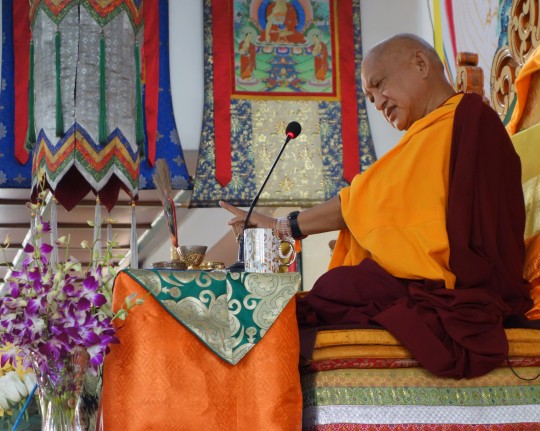
Lama Zopa Rinpoche teaching at the 100 Million Mani Retreat in Mongolia, Ulaanbaatar, Mongolia, August 2014. Photo by Ven. Roger Kunsang.
“Lama Zopa: If you are wise, practice rejoicing in others’ and one’s own good karma. Feel a sense of joy in others’ good deeds and actions.”
– From Ven. Roger Kunsang’s Twitter page, posted on August 30, 2014
Ven. Roger Kunsang, Lama Zopa Rinpoche’s assistant and CEO of FPMT Inc., shares Lama Zopa Rinpoche’s recent pith sayings on Ven. Roger’s Twitter page. (You can also read them on Ven. Roger’s Facebook page.)
More information, photos and updates about FPMT spiritual director Lama Zopa Rinpoche can be found on Rinpoche’s homepage. If you’d like to receive news of Lama Zopa Rinpoche via email, sign up to Lama Zopa Rinpoche News.
- Tagged: lama zopa rinpoche, mandala, rejoice, twitter
- 0
- Home
- News/Media
- Study & Practice
- About FPMT Education Services
- Latest News
- Programs
- New to Buddhism?
- Buddhist Mind Science: Activating Your Potential
- Heart Advice for Death and Dying
- Discovering Buddhism
- Living in the Path
- Exploring Buddhism
- FPMT Basic Program
- FPMT Masters Program
- FPMT In-Depth Meditation Training
- Maitripa College
- Lotsawa Rinchen Zangpo Translator Program
- Universal Education for Compassion & Wisdom
- Online Learning Center
- Prayers & Practice Materials
- Overview of Prayers & Practices
- Full Catalogue of Prayers & Practice Materials
- Explore Popular Topics
- Benefiting Animals
- Chenrezig Resources
- Death & Dying Resources
- Lama Chopa (Guru Puja)
- Lama Zopa Rinpoche: Compendium of Precious Instructions
- Lama Zopa Rinpoche: Life Practice Advice
- Lama Zopa Rinpoche Practice Series
- Lamrim Resources
- Mantras
- Prayer Book Updates
- Purification Practices
- Sutras
- Thought Transformation (Lojong)
- Audio Materials
- Dharma Dates – Tibetan Calendar
- Translation Services
- Publishing Services
- Teachings and Advice
- Find Teachings and Advice
- Lama Zopa Rinpoche Advice Page
- Lama Zopa Rinpoche: Compendium of Precious Instructions
- Lama Zopa Rinpoche Video Teachings
- ༧སྐྱབས་རྗེ་བཟོད་པ་རིན་པོ་ཆེ་མཆོག་ནས་སྩལ་བའི་བཀའ་སློབ་བརྙན་འཕྲིན།
- Podcasts
- Lama Yeshe Wisdom Archive
- Buddhism FAQ
- Dharma for Young People
- Resources on Holy Objects
- Ways to Offer Support
- Centers
- Affiliates Area
- Teachers
- Projects
- Charitable Projects
- Make a Donation
- Applying for Grants
- News about Projects
- Other Projects within FPMT
- Support International Office
- Projects Photo Galleries
- Give Where Most Needed
- FPMT
- Shop
Translate*
*powered by Google TranslateTranslation of pages on fpmt.org is performed by Google Translate, a third party service which FPMT has no control over. The service provides automated computer translations that are only an approximation of the websites' original content. The translations should not be considered exact and only used as a rough guide.Without the practice of morality, there’s no enlightenment, no liberation from samsara, not even good rebirths in future lives.







